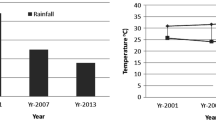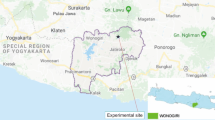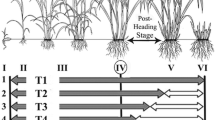Abstract
A 2-year field experiment was conducted during the wet seasons (July–October) of 2008 and 2009 on a Typic Hapludoll Mollisol in Indo-Gangetic Plains Region (IGPR) to: (i) investigate the effects of field water re-ponding intervals and plant spacing on the growth, yield, and water productivity (WP) of two rice cultivars under system of rice intensification (SRI) management, and (ii) assess comparative performance of SRI versus ‘best management practices’(BMP) of rice cultivation. This experiment was designed with 14 treatments, 12 under SRI, and 2 BMP (controls). SRI treatments comprised of 3 irrigation regimes viz, irrigation at 1, 3, and 5 day(s) after disappearance of ponded water (DADPW), 2 plant spacings (20 × 20, 25 × 25 cm), and 2 rice cultivars (Pant Dhan 4 and Hybrid 6444). Two BMP (control) treatments comprised of standard cultivation recommendations for flooding and spacing. The experiment was laid-out in a factorial randomized complete block design with three replications. Statistical analysis of data revealed significant variations in root–shoot characteristics and rice yield under SRI between years, reflecting different rainfall patterns. During 2009, a low rainfall year, the panicle numbers m−2, dry root weight m−2, root volume m−2, filled spikelet number panicle−1, and filled spikelet weight panicle−1 were significantly higher, which resulted in a rice grain yield enhancement by 5.1 % over 2008, when there was unusually heavy rainfall. Climate × irrigation regime interaction revealed a non-significant influence of irrigation regimes on growth and yield during 2008, whereas in 2009, irrigation at 1 DADPW and 3 DADPW increased grain yield by 12.8 and 8 %, respectively over 5 DADPW. Better root–zone soil moisture regimes, balancing water, and oxygen availability were responsible for higher yields under irrigation at 1 and 3 DADPW. In 2008, soil moisture content (SMC) in 0–15 cm layer was 91, 86, and 82 % of field capacity (FC) at panicle initiation, and 88, 80, and 77 % at panicle emergence stage when irrigation was at 1, 3, and 5 DADPW, respectively; the lower layers (15–30, 30–45 cm) retained their SMC between 87 and 94 % of FC at both stages. During 2009, SMC in all the three layers at both stages was more than 85 % of FC when irrigating at 1 DADPW, and a little more than 70 % for the 0–15 cm layer and >80 % for the other two layers when irrigation was done at 3 DADPW. SMC dropped to below 60 % of FC in the 0–15 cm layer and remained between 67 and 77 % of FC in the other two layers, with lower yield resulting when irrigations were applied at 5 DADPW. However, WP was the highest with irrigation at 5 DADPW (38.5 kg ha cm−1). Wider plant spacing (25 × 25 cm) resulted in generally and significantly higher grain yield and WP. On an average, SRI (6.1 t ha−1) resulted in yield advantage of 0.9 t ha−1 over BMP (5.2 t ha−1). Overall, it is inferred that in SRI, wider planting (25 × 25 cm) with field re-ponding at 3 DADPW if there is adequate water availability and at 5 DADPW under limited water supply conditions, may lead to higher rice yields and WP in sub-humid tarai Mollisols of IGPR and comparable agro-climatic conditions in Indian sub-continent.




Similar content being viewed by others
References
Babu PR (2007) Response of rice varieties to SRI method of cultivation. In: Proceedings of 2nd national symposium on SRI in India—progress and prospects, 3–5 Oct 2007, Agartala, India, pp 57–58
Bagayoko M (2012) Effects of plant density, organic matter and nitrogen rates on rice yields in the system of rice intensification (SRI) in the “Office du Niger” in Mali. ARPN J Agric Biol Sci 7(8):620–632
Bagg JE, Turner NC (1976) Crop water deficits. Adv Agron 28:161–217
Barah B (2009) Economic and ecological benefits of SRI in Tamil Nadu. Agric Econ Res Rev 22:209–214
Black CA (1971) Methods of soil analysis. Part II. American Society of Agronomy. Inc. Publisher, Madison
Chandrasekaran D, Khan AK, Behera MS, Anand PSB, Ghosh S, Panda DK (2008) Effect of varying irrigation schedules and fertility levels on water saving and yield of hybrid rice. Indian J Agric Sci 78(2):122–126
Chapagain T, Yamaji E (2010) The effects of irrigation method, age of seedling and spacing on crop performance, productivity and water-wise rice production in Japan. Paddy Water Environ 8:81–90
Choudhary AK, Singh A, Singh A, Yadav DS, Sood P (2010) SRI—a boon to enhance rice productivity in NW Himalayas. In: Proceedings of 3rd international rice congress, 8–12 Nov 2010, Hanoi, Vietnam, p 159
Chowdhury Md R, Kumar V, Sattar A, Brahmachari K (2014) Studies on water-use efficiency and nutrient uptake by rice under SRI. Bioscan 9(1):85–88
Dass A, Chandra S (2012) Effect of different components of SRI on yield, quality, nutrient accumulation and economics of rice in tarai belt of northern India. Indian J Agron 57(3):250–254
Dass A, Chandra S (2013) Irrigation, spacing and cultivar effects on net photosynthetic rate, dry matter partitioning and productivity of rice under SRI in Mollisols of northern India. Exp Agric 49(4):504–523
Dawood AS, Budhar MN, Chandrasekaran B (1990) Study of irrigation for lowland rice. Indian J Agron 25:380–385
Gani A, Rahman A, Rustam D, Hengsdijk H (2002) Synopsis of water management experiments in Indonesia. In: Bouman BAM, Hengsdijk H, Hardy B, Bindraban PS, Tuong TP, Ladha JK (eds) Water-wise rice production. IRRI, Philippines, pp 29–37
Hameed KA, Jaber FA, Mosa AJ (2013) Irrigation water-use efficiency for rice production in southern Iraq under SRI management. Taiwan Water Conserv 61(4):86–93
Hsiao TC (1973) Plant responses to water stress. Ann Rev Plant Physiol 24:519–570
Husain AM, Chowhan PB, Uddin AFM, Rahman ABM (2004) Final evaluation report on verification and refinement of SRI project in selected areas of Bangladesh. PETRRA-Project, IRRI, Dhaka
Jackson ML (1967) Soil chemical analysis. Prentice Hall Pvt Ltd, New Delhi
Jackson ML (1973) Soil chemical analysis. Prentice Hall Pvt Ltd, New Delhi 498p
Kassam A, Stoop W, Uphoff N (2011) Review of SRI modifications in rice crop and water management and research issues for making further improvements in agricultural and water productivity. Paddy Water Environ 9:163–180
Krishna A, Biradarpatil NK, Manjappa K, Channappagoudar BB (2008) Evaluation of system of rice intensification cultivation, seedling age and spacing on seed yield and quality in Samba Masuhri (BPT-5204) rice. Karnataka J Agric Sci 21(1):20–25
Latif MA, Islam MR, Ali MY, Saleque MA (2005) Validation of system of rice intensification (SRI) in Bangladesh. Field Crops Res 93:281–292
Latif MA, Ali MY, Islam MR, Badshah MA, Hasan MS (2009) Evaluation of management principles and performance of SRI in Bangladesh. Field Crops Res 114(2–3):255–262
Lindsay WL, Norvell WA (1978) Development of DTPA soil test for zinc, iron, manganese and copper. Soil Sci Soc Am J 42:421–428
Menete MZL, Vanes HM, Brito RML, De Gloria SD, Famba S (2008) Evaluation of SRI component practices and their synergies on salt-affected soils. Field Crops Res 109(1–3):34–44
Namara RE, Weligamage P, Barker R (2003) Prospects for adopting SRI in Sri Lanka: A socio-economic assessment research report—75. IWMI, Colombo
Olsen SR, Cole CV, Watanable FS, Dean LA (1954) Estimation of available phosphorus in soils by extraction with sodium bicarbonate. USDA Circular No. 939:19
Pandey N, Upadhyaya SK, Tripathi RS (2006) Effect of irrigation management on grain yield and moisture use of rice and moisture content in grain and soil. J Agric Issues 11(2):61–66
Piper CS (1950) Soil and plant analysis, Indian edn. Hane Publication, Bombay
Rangaswamy R (2006) A text book of agricultural statistics. New Age International Pub, New Delhi
Rao YY (2012) Rice seed production scenario in India rice knowledge management portal. Directorate of Rice Research, Hyderabad
Saha A, Kumar MR, Bharti V (2007) SRI—a new method for rice production. Indian FMG 57(2):20–25
Salisbury FB, Ross CW (2009) Plant physiology, 3rd Indian Reprint 2009. Cengage Learning India Pvt Ltd, New Delhi
Satyanarayana A, Thiyagarajan TM, Uphoff N (2007) Opportunities for water saving with higher yield from SRI. Irrig Sci 25:99–115
Senthilkumar K, Bindraban P, Thiyagarajan T, De Ridder N, Giller K (2008) Modified rice cultivation in Tamil Nadu, India: yield gains and farmers’ lack of acceptance. Agric Syst 98:82–94
Sharma PK (1989) Effect of periodical moisture stress on water-use efficiency in wetland rice. Oryza 26(3):252–257
Shrirame MD, Rajgire HJ, Rajgire AH (2000) Effect of spacing and seedling number per hill on growth attributes and yield of rice hybrids under lowland condition. J Soils Crops 10(1):109–113
Sinclair TR (2004) Agronomic UFOs waste valuable scientific resources. Rice Tod 3:43
Singh YV (2012) Crop and water productivity as influenced by rice cultivation methods and organic and inorganic sources of nutrient supply. Paddy Water Environ 11(1–4):531–542
Stoop W, Uphoff N, Kassam A (2002) A review of agricultural research issues raised by the SRI from Madagascar: opportunities for improving farming systems for resource-poor farmers. Agric Syst 71:249–274
Subbaiah BV, Asija GL (1956) A rapid procedure for the determination of available nitrogen in soil. Curr Sci 25:259–262
Thakur AK, Choudhary SK, Singh R, Kumar A (2009) Performance of rice varieties at different spacing grown by the systems of rice intensification (SRI) in eastern India. Indian J Agric Sci 79(6):443–447
Thakur AK, Rath S, Roychowdhury S, Uphoff N (2010) Comparative performance of rice with SRI and conventional management using different plant spacings. J Agron Crop Sci 196(2):146–159
Tripathi RP (1990) Water requirement in rice-wheat system. Rice-Wheat Workshop, Modipuram
Uphoff N, Randriamiharisoa R (2002) Possibilities for reducing water use in irrigated rice production through the Madagascar system of rice intensification (SRI). In: Bouman BA et al (eds) Water-wise rice production. International Rice Research Institute, Los Baños, pp 71–87
Uphoff N, Kassam A, Hardwood R (2011) SRI as methodology for raising crop and water productivity: productive adaptations in rice agronomy and irrigation water management. Paddy Water Environ 9:3–11
Whitefield DM, Smith CJ (1989) Effect of irrigation and nitrogen on growth, light interception and efficiency of light conversion in wheat. Field Crops Res 20(4):279–292
Williams CH, Steinbergs A (1959) Soil sulfur fractions as chemical indices of available sulfur in some Australian soils. Aust J Agric Res 10:340–352
USDA (1954) Diagnosis and improvement of saline and alkali soils. In: Richards LA (ed) USDA Handbook No. 60. USDA, Washington DC
Yang C, Yang L, Yang Y, Ouyang Z (2004) Rice root growth and nutrient uptake as influenced by organic manure in continuously and alternatively flooded paddy land. Agric Water Manag 70(1):67–81
Zhao L, Wu L, Li Y, Lu X, Zhu D, Uphoff N (2009) Influence of SRI on rice yield and nitrogen-and water-use efficiency with different N application rates. Expl Agric 45:275–286
Acknowledgments
Authors wish to express their gratitude to the All India Coordinated Research Project on Water Management for providing financial and technical support. Authors gratefully acknowledge Dr. A. R. Sharma, Director, DWSR, Jabalpur, India and both reviewers of the article for their valuable suggestions in improving the manuscript.
Author information
Authors and Affiliations
Corresponding author
Rights and permissions
About this article
Cite this article
Dass, A., Chandra, S., Choudhary, A.K. et al. Influence of field re-ponding pattern and plant spacing on rice root–shoot characteristics, yield, and water productivity of two modern cultivars under SRI management in Indian Mollisols. Paddy Water Environ 14, 45–59 (2016). https://doi.org/10.1007/s10333-015-0477-z
Received:
Revised:
Accepted:
Published:
Issue Date:
DOI: https://doi.org/10.1007/s10333-015-0477-z




